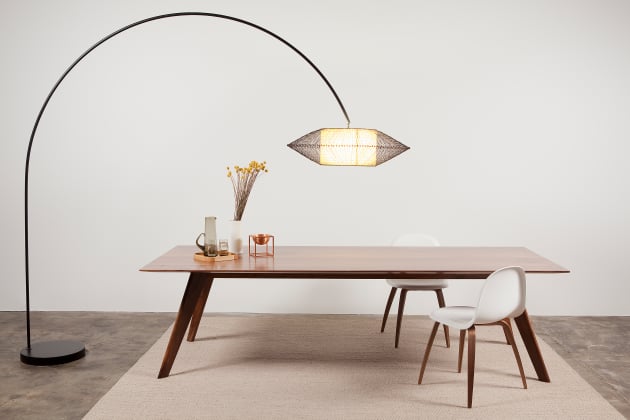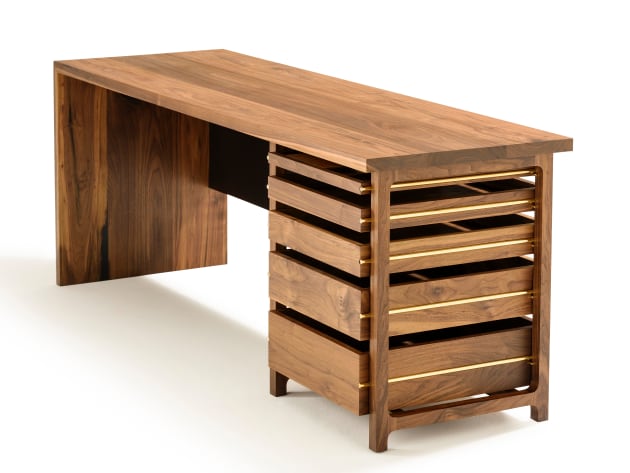Meet the AWR L!VE Speakers: Fred Kimel
Fred Kimel (left) discusses a brief with Sydney maker Tim Noone.
Fred Kimel is founder and director of Handkrafted, an online platform for bespoke makers. He will speak at AWR L!VE and take part in panel discussions. For more information and earlybird ticketing see here. We spoke to Fred about the creation of Handkrafted and asked him what some of the current trends are for both makers and buyers.
AWR: You have created a vibrant online platform for people to commission furniture and fitouts from bespoke makers. What prompted you to establish Handkrafted three years ago?
FK: I’ve always felt strongly about quality craftsmanship and the importance of investing in beautiful products that are built to last. Like many people, I developed a kind of nostalgia for a bygone era in which I hadn’t even lived: a simpler time when people made things to last many generations – and looked after them. They were ultimately the values that led me to launch Handkrafted – a platform to showcase incredibly talented furniture makers who create high quality bespoke products.
AWR: How many makers do you now represent, and how many commissions does Handkrafted annually facilitate?
FK: While we have over 350 registered makers Australia-wide covering a broad range of styles and specialisations – the reality is that like most online marketplaces, there’s one of those ever-present 80/20 rules at play where 20% of those makers typically make up 80% of the commissions. Our platform facilitates hundreds of bespoke projects each year and while that number continues to grow year-on-year – the type of project continues to evolve.

Sideboard by Jonathan West
AWR: How has the landscape for makers and consumers changed over the past three years?
FK: I started Handkrafted given my view that we’ll continue to see a growing interest in local handmade products – from food to furniture and everything in between. People want to know the story behind the product (not just where it’s made, but how, who by and using what materials). That’s wonderful in many respects, yet it’s not all cigars and champagne for local furniture makers!
We still have a long way to go to help educate the typical consumer on the costs involved in local high-quality craftsmanship. While customers love the idea of working with local makers, many potential clients struggle to comprehend the costs involved. Our role is often to help educate them on the cost factors involved and help to re-shape their perceptions of value.
Desk in walnut by Matt Pearson, MJP Studio
AWR: What do most clients want in terms of items and style? How have needs and budgets changed and what are the new trends?
FK: My view is that our typical clients want simple, well designed pieces that are made to last and incorporate beautiful and high quality timber and materials. Classic timbers like American oak and walnut will always remain popular, yet I feel that there’s a growing interest in the rich and featured grains of unique Australian timbers like messmate, wormy chestnut, marri and many others.
Our typical and target client is likely to be much more environmentally conscious than your average consumer. Many are wanting more sustainably made alternatives to what’s typically available at retailers – in terms of material selection, finishes and production processes. The lifespan of a well-made piece is ultimately what makes it a much more sustainable choice when compared with poor quality furniture destined for the tip.

Walnut Whisky Cabinet by Christopher Blank
AWR: How realistic are most clients in terms of budget and timeframe?
Timeframes are rarely an issue for our clients – with most happy to accept the 6-12 week timeframes most of our makers typically work within. It’s worth keeping in mind that the alternatives in the premium end of the market are rarely much quicker anyway, particularly when ordering from design furniture brands based overseas.
Budget expectations are sadly not always reasonable – with many consumers simply unaware of what costs are involved when commissioning a local maker to produce a high-quality bespoke piece. Together with our makers, we regularly need to help explain and educate clients on those cost factors, and importantly in what ways the end product may be superior to off-the-shelf products mass produced overseas. We’ll often have clients more than double their budget after they gain an appreciation for what’s involved and better understand the benefits of working with local makers.

Bellbrae Buffet, Bombora Custom Furniture
AWR: What do new makers often omit to do in terms of marketing themselves?
I believe a maker’s own personal backstory is important when marketing their business, and it’s often overlooked. People increasingly want to connect with the person behind the product so helping to learn a little about the maker helps them to build a stronger emotional connection.
PR can also be very valuable and is often assumed to be only for bigger brands – but it’s easy to do yourself. You’ll find plenty of tips online and it often starts with pulling together a simple media kit containing high-quality photography and succinct copy about you and your brand. You can then directly approach editors and publishers to introduce yourself and over time build a rapport with them as you release new products or ranges. Depending on the size of your business and product range, platforms like Flaunter.com can be an invaluable resource to make your content discoverable and accessible by media.

Walnut dresser, Tim Noone
AWR: What is your best advice to new makers?
FK: Have a long hard think about the type of business you aspire to build and try to define what success looks like for you. Consider your values and the type of work and projects do you most (and least) enjoy.
It’s without any doubt a tough industry and many of our makers are still searching for the path to turn their passion into a more sustainable business commercially that is viable in the long-term.
Do you want to focus on the making or design – would you consider outsourcing production? Do you like working with clients on bespoke projects or only your own designs? Do you enjoy the client interaction and sales/marketing, or will you need to find others to support you in that respect?
You don’t need to have all the answers, however asking yourself the questions and consciously evaluating options is a great first step. You may even want to approach other more experienced makers as potential mentors – a relationship which could be as informal as catching up over a beer or coffee once every other month to get first hand insights based on their experiences.

Nathan Day, WA, Vista dining table
AWR: What do you enjoy most about your job?
FK: As cheesy as it probably sounds, I love seeing a client brief come to life and learning of the joy they inevitably always experience in working directly with a maker on a piece that’s been made exclusively for them.
See www.handkrafted.com.au for more information
AWR L!VE is an exciting half day conference event for pro and aspiring pro woodworkers which will take place in Sydney, August 21, 2017. For more information and earlybird ticketing see here.
AWR L!VE is proudly sponsored by:





